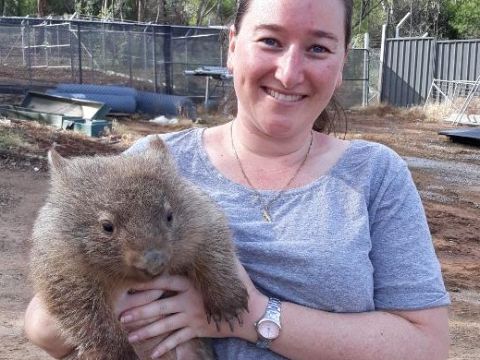- Charles Sturt University researcher hopes virtual fencing implemented in regions that have high wombat roadkill rates may aid in reducing road deaths
- Collisions with motor vehicles causes significant damage to the vehicle and sometimes the vehicle driver and other occupants, as well as wounding or killing the wombat
- NRMA Insurance claims data shows there were over 13,000 collisions involving animals in 2019, including wombats, kangaroos, cattle, deer, etc.
A Charles Sturt University researcher hopes to conserve wombat populations and minimise road accidents by exploring the use of ‘virtual fences’.
Lecturer in Veterinary and Animal Physiology Dr Hayley Stannard (pictured, with wombat) in the Charles Sturt School of Agricultural, Environmental and Veterinary Sciences said roadkill is a worldwide issue that can cause extinctions of particular local wildlife population.
“In Australia, numerous species are affected, however, the bare-nosed wombat (Vombatus ursinus) is particularly vulnerable due to its preference for disturbed habitats,” she said.
“Collisions with motor vehicles causes significant damage to the vehicle and sometimes the driver and other vehicle occupants, as well as wounding or killing the wombat.”
 Dr Stannard said bare-nosed wombats are semi-fossorial ecosystem engineers with an important role in the ecosystem and despite being listed as ‘Least Concern’ are readily impacted by collisions with vehicles.
Dr Stannard said bare-nosed wombats are semi-fossorial ecosystem engineers with an important role in the ecosystem and despite being listed as ‘Least Concern’ are readily impacted by collisions with vehicles.
“Virtual fencing implemented in regions that have high wombat roadkill rates may aid in reducing road deaths and species conservation,” she said.
“Virtual fences are light and sound-based devices, originally developed in Austria, that can be used to reduce roadkill through mitigation.
Dr Stannard’s study was done in collaboration with local wildlife carers Marie and Ray Wynan from Jarake Wildlife Sanctuary, Snowy Monaro Regional Council, and researchers from Western Sydney University.
In the study a virtual fence was installed along a one-and-a-half kilometre stretch of road in semi-rural NSW, with the aim of reducing wombat roadkill through the use of this form of mitigation strategy.
The number of road-killed wombats was counted before and after the fence was installed in March 2020. Prior to the fence being installed, 23 wombats were killed, and after the fence was installed, six wombats were killed.
In comparison, along Old Bega Road outside of the fenced area, 64 wombats were killed pre-fence installation and 17 were killed post-fence installation.
Dr Stannard noted that NRMA Insurance claims data shows there were over 13,000 collisions involving animals in 2019 (includes kangaroos, wombats, cattle, deer, etc), and rural areas have higher rates of vehicle-animal collisions. On the rare occasion, hitting a wombat can result in human fatality.
She said more research is required to assess virtual fencing, as a roadkill mitigation strategy, including an investigation into a larger number of species in a range of different habitats.
“We do need to do more research to look at how the animals actually react to virtual fences,” she said.
“Do they react to the lights and sounds and how can these be used effectively? Or do we design something that is more specific to wombats?
“We probably also need to do more research on humans, looking at effective strategies to get people to slow down in areas with high wildlife densities near roadsides, and possibly build underpasses and overpasses for wildlife too.
“Hopefully virtual fences would reduce the chances of collisions with wombats, or any wildlife, and therefore damage to cars, injuries from car accidents, and claims to insurance companies, which could reduce insurance premiums.”
Dr Stannard, who has been doing this research for about two years (slowed by COVID-19), said it can be used for other wildlife, such as kangaroos and Tasmanian devils. Virtual fence research has been tried with other animals in Australia previously in the west coast of Tasmania and south of Hobart.
If readers are interested, they can access the WomSAT webpage and acquire the mobile phone app, which allows citizen scientists to upload sightings (alive/dead/scats/burrows) of wombats.
Uploading sightings to the webpage/app will further the knowledge about wombat distribution, sarcoptic mange prevalence, and location of roadkill hotspots.






Social
Explore the world of social